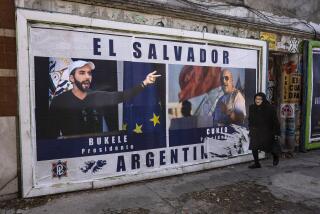Simon Bolivar Still Stirs Passions 164 Years Later : History: When an unflattering painting of the revolutionary hero was included in an exhibition at a London gallery, South Americans were incensed.
- Share via
CARACAS, Venezuela — Simon Bolivar died 164 years ago, but the passion of South Americans for “The Liberator” still burns hotly and is not to be trifled with.
When an unflattering painting depicting the revolutionary hero as partly clothed with female breasts and making an obscene gesture was included in an exhibition at a London gallery, South Americans were incensed.
Venezuelans massed at their native son’s imposing statue near Congress in August and demanded the painting by Chilean artist Juan Davila be burned. Diplomats from Colombia, Ecuador and Bolivia protested to Chile’s government, which also criticized the artwork. The flap was front-page news.
“I’m crying because it hurts me,” a housewife, Aurora Pineda, screamed into a megaphone at the Caracas demonstration. “It’s not right that the father of our country be mocked.”
University student Litdell Diaz also spoke: “My dignity is offended. Bolivar is here. He’s not dead. He’s in each one of his children.”
The man who led five South American nations to independence from Spain, and dreamed of creating a sort of United States of South America, is much more than a dusty historical figure.
His deeds and thoughts resonate in Bolivia, which was named for him, and in Colombia, Peru and Ecuador. But they are felt perhaps most of all in this Caribbean nation where he was born in 1783 and which still laments his lonely flight to exile and early death at age 47.
“The cult of Bolivar is the main reason for unity among Venezuelans,” former President Ramon J. Velasquez, a historian, said in an interview. “His ideas are still current. They’re not just something you go to the library to read about.”
Venezuela’s current president, Rafael Caldera, also is a Bolivar fan. In an essay published last June, he saluted Bolivar for being the “highest expression” of Venezuela’s values and an inspiration for its constitution.
“He was a great romantic dreamer, but he was also a man of action, and he didn’t subjugate an entire continent as Napoleon did--he liberated it,” said British filmmaker Michael Cooper, who plans an epic movie that he hopes will thrust Bolivar back into the spotlight outside South America.
Cooper promises his film will reflect the grandeur of Bolivar and his accomplishments, but South Americans are wary. Many feel Colombian author Gabriel Garcia Marquez tarnished Bolivar’s reputation with “The General in His Labyrinth.” That best-selling 1989 novel depicted Bolivar in his final days as rejected and bitter.
Anything less than a glowing tribute is likely to mean trouble for Cooper. He acknowledges he faces the same situation that American director Oliver Stone confronted in trying to film a version of the play “Evita,” about the famed wife of the 1940s and ‘50s Argentine leader Juan Peron.
Some Argentines consider her a saint for her work for the poor. So when President Carlos Menem of Argentina found out the movie might depict her as power-hungry and promiscuous, Stone was blocked from filming at government buildings. He ended up shelving the project.
Bolivar portraits are ubiquitous in Venezuela. The standard one, a reproduction of an 1825 oil painting, shows him standing confidently with one gloved hand tucked into a tight military waistcoat, the other gripping a sword in a decorated scabbard, looking serenely content, a man of destiny.
On his birthday, July 24, newspapers still publish his portrait on the front page. Venezuelans can tell you the year he died, 1830. The exact date, too: Dec. 17. It’s a national holiday. So is his birthday.
In most every city and village, “Liberator” avenue is a main thoroughfare, and a well-tended Bolivar Plaza is located outside a prominent church, government building or military base.
More to Read
Sign up for Essential California
The most important California stories and recommendations in your inbox every morning.
You may occasionally receive promotional content from the Los Angeles Times.













